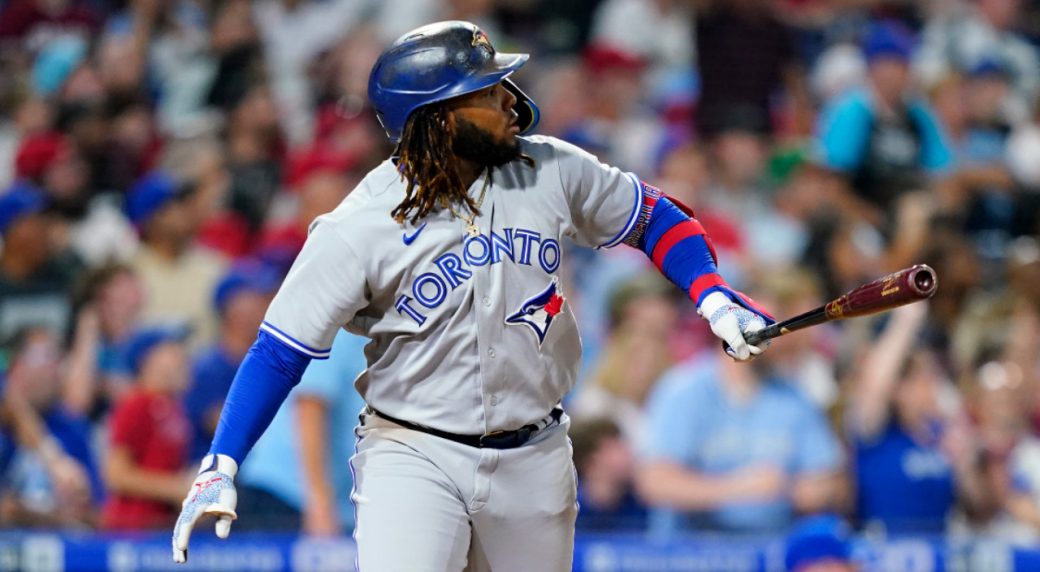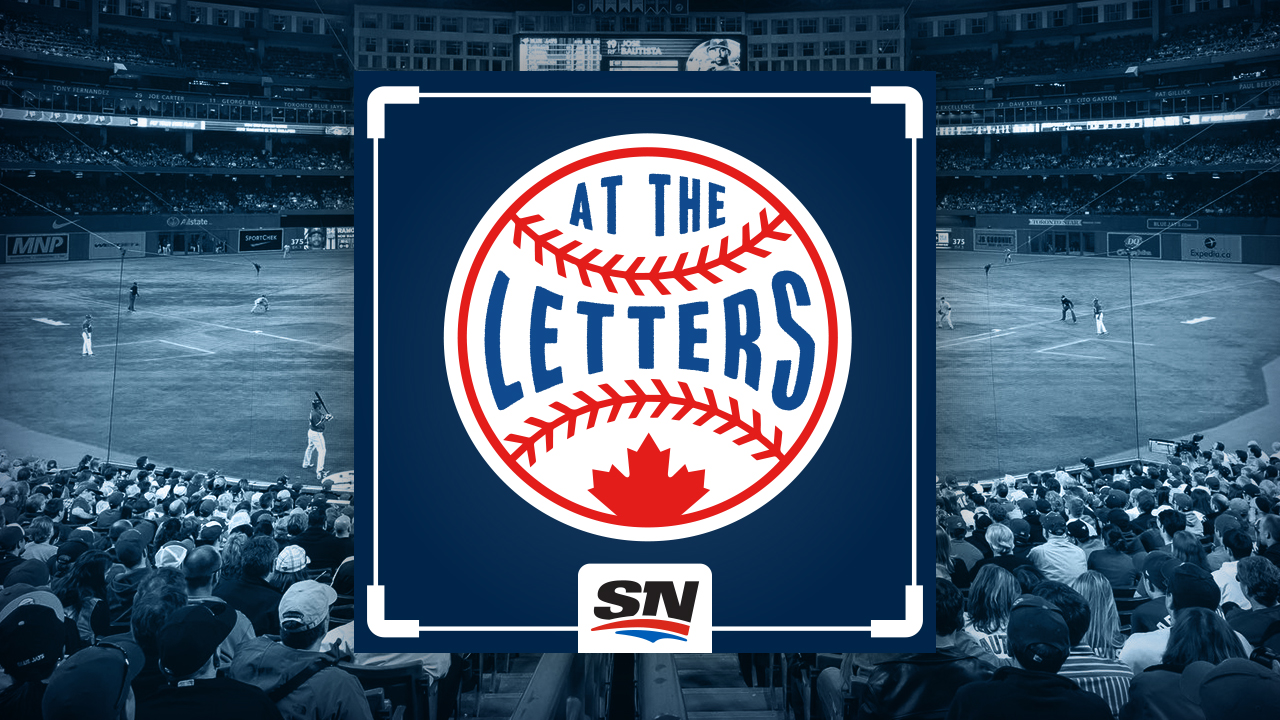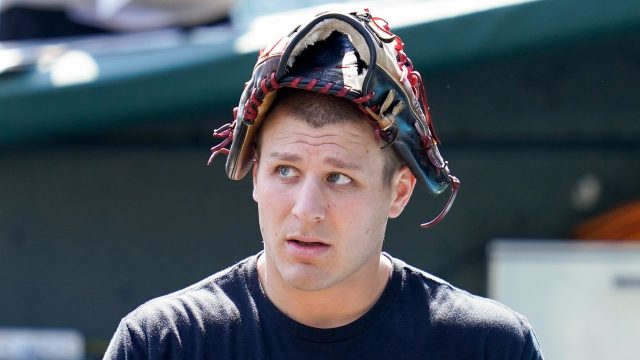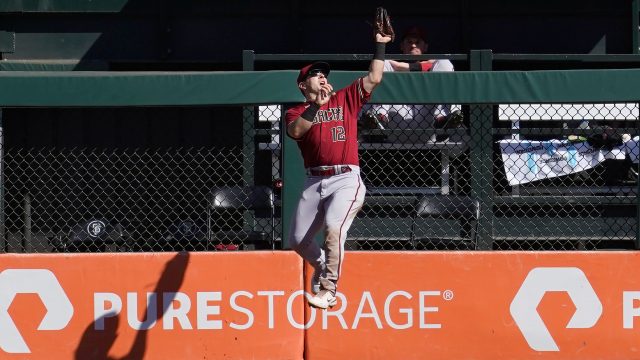When evaluating team building, it’s intuitive to emphasize the quality of players a front office brings on from outside the organization.
Hitting on marquee free-agent signings and winning trades is the most obvious way a baseball operations department can excel, but making evaluations on players outside your building is just one piece of the puzzle.
Equally important is the internal evaluations you make on your own guys. Every year teams gather more information about which of their existing players are worth building on, giving different roles to, or moving on from.
The Daulton Varsho trade, for instance, required the Blue Jays to spend as much time contemplating the value and career trajectory of Gabriel Moreno — a potential long-term building block — as they did doing their homework on Varsho.
Every year there is more to learn about your own players, and as 2022 comes to a close it’s a good time to review what the Blue Jays know about their core that they didn’t prior to the season.
In order to be considered a core player — by my admittedly arbitrary definition — you have to:
1. Be under team control through at least 2025
2. Project to be an above-average regular in 2023 (More than 2.0 fWAR by Steamer)
3. Have played all of 2022 with the Blue Jays
4. Be a position player or starting pitcher (unless you’re one of the top, top relievers the volatility is too high)
With that in mind, here’s a summary of what the Blue Jays learned about their core in 2022 (plus some notes on notable guys who don’t fit this criteria but will be around for a while):
.acf-block-preview .br-snippet {
display: grid;
grid-template-columns: 200px 1fr;
gap: 20px;
width: 100%;
margin: 0 auto;
padding: 16px;
border: 1px solid #CECECE;
background-color: #FFF;
border-radius: 4px;
}
.acf-block-preview .br-snippet-info a {
text-decoration: none;
}
.acf-block-preview .br-snippet-info .br-snippet-title {
color: #343434;
font-family: ‘roboto’;
font-size: 20px;
font-weight: 600;
line-height: 22px;
margin-bottom: 10px;
top: -3px;
}
.acf-block-preview .br-snippet-info .br-snippet-body {
color: #343434;
font-family: ‘urw-din’;
font-size: 16px;
line-height: 20px;
margin-bottom: 12px;
}
.acf-block-preview .br-snippet-info .br-snippet-link-title {
display: inline-block;
font-family: ‘urw-din’;
font-size: 16px;
list-style-type: none;
width: auto;
}
.acf-block-preview .br-snippet-info .br-snippet-link-title:not(:last-child):after {
content: ‘ | ‘;
color: #343434;
}
Vladimir Guerrero Jr.
What they learned: The groundball worries aren’t gone for good
After Guerrero Jr. broke out in 2021 with an elite offensive season, it was easy to envision him establishing himself as a perennial MVP candidate.
That could still happen, but he took a notable step back in 2022 as his wRC+ dropped from 166 to 132. In retrospect, some regression to mean isn’t shocking, but based on Guerrero Jr.’s raw tools and prospect pedigree it felt like he had taken off for good after 2021.
While his 2022 was still solid, his groundball rate spiked back to the levels he showed in his first two seasons.
Even at his best in 2021 he hit grounders at an above-average rate, but when half of his balls in play are in the dirt it will be tough for him to reach his ceiling.
It looked like he’d buried that worry last year, but it’s returned to ‘ongoing concern’ status.
Bo Bichette
What they learned: You know exactly what you’re going to get from his bat
Bichette entered 2022 with only one full season under his belt, and while his results were good his offensive profile was a bit odd.
The shortstop doesn’t walk much, strikes out a fair amount and possesses power that’s more above-average than elite. For that profile to result in excellent production they need to convert a disproportionate number of balls in play into hits.
For most of the year, Bichette’s ability to do that wavered. He entered September with a pedestrian 106 wRC+ thanks in large part to a .320 BABIP that was well below his career average (.347).
From September 1 to the end of the season Bichette hit .406/.444/.662 and when it was all said and done his numbers for the year looked extremely similar to what he’d produced the previous two years — from his overall numbers to his BABIP.
|
Season |
wRC+ |
wOBA |
BABIP |
|
2020 |
120 |
.353 |
.352 |
|
2021 |
122 |
.354 |
.339 |
|
2022 |
129 |
.347 |
.347 |
Alejandro Kirk
What they learned: Defence doesn’t have to be a weakness
Kirk’s bat has always been tantalizing, but coming into 2022 it was fair to conceptualize him as a part-time catcher with defensive limitations who was going to need plenty of DH at-bats.
While he may never win a Gold Glove, Kirk changed that perception by obliterating his presumed defensive ceiling. Last season the 24-year-old threw base runners out at an above-average rate, let fewer balls get past him in 654 innings (13) than he did in 338 in 2021 (20), and ranked in the 94th percentile among framers.
That colossal step forward changed him from an intriguing role player, to one of the Blue Jays’ foundational pieces.
His work with the bat was impressive (129 wRC+), but that wasn’t particularly surprising as his expected stats in 2021 indicated he could do more offensively. Kirk’s power actually took a slight step back with his power in 2022 and his xwOBA (.351) was worse than his 2021 number (.373).
Alek Manoah
What they learned: The soft contact stuff is for real
Thanks to his imposing physical presence Manoah has the look of a pure power pitcher, but he’s better at inducing harmless contact than blowing hitters away.
As a rookie his ERA was 58 points lower than his FIP and he allowed an abnormally low .246 BABIP. It was worth wondering if he got a bit lucky in his first year and could be in for a step back in 2022.
It would be an understatement to say that didn’t come to pass. Manoah gave the Blue Jays 196.2 innings of 2.24 ERA ball last season, a performance that landed him third in Cy Young voting.
Once again he showed the ability to allow soft contact, and we now have over 300 innings of Manoah conceding a .245 BABIP. In each of the last two seasons the right-hander has been in the top 10 per cent of pitchers at suppressing hard-hit balls and top 20 per cent at preventing barrels.
When it comes to generating harmless balls in play, Manoah is now a proven commodity.
George Springer
What they learned: How to manage Springer’s workload
In 2021 Springer was outstanding for the Blue Jays when he suited up, but multiple injuries held him to just 78 games.
Given his age and the way he plays the game, it is impossible to totally minimize injury risk with Springer, but Toronto has to be happy with getting 133 games out of him in 2022.
This was the team’s first season having Springer from April to September and they played him at DH 40 times and were unafraid to give him maintenance days throughout.
It’d be hard to claim they cracked the code entirely, as luck plays a significant role. For example there’s nothing the team could’ve done to avoid the flukey collision Springer suffered in the playoffs.
What the Blue Jays did do is create a template they can work off of in 2023, because their plan was largely successful in 2022. When Springer played he produced at a high level offensively (132 wRC+), graded out as an approximately average centre fielder, and even produced his highest stolen base total (14) since 2015.
It will be interesting to see how a move to playing primarily right field will affect his workload management next year.
Kevin Gausman
What they learned: The AL East suits Gausman just fine
Before reaching the San Francisco Giants in 2020 Gausman had been a solid starter at times but he’d never lived up to his prospect pedigree.
When he took off with San Francisco, it was worth wondering if escaping the DH and working in the pitcher-friendly parks of the NL West was a significant part of his breakout.
When Toronto signed Gausman to a $110-million contract the club was taking a chance on 43 starts with San Francisco being far more representative of his talents than the rest of his career.
The Blue Jays were right to take the plunge. In 2022 Gausman led the American League in FIP and earned down-ballot Cy Young consideration. He even brought his walk rate to a career-low level and posted his lowest HR/9 since 2014.
Gausman may have taken his star turn in San Francisco, but his stuff plays anywhere.
BEYOND THE INNER CORE
Jose Berríos: It didn’t take long for Berríos to go from a sure thing to a question mark. In every season between 2017 and 2021 the right-hander was an above-average starter with an ERA- between 92 and 80 and a FIP- between 92 and 82.
Whether you wanted to evaluate him by run-suppression or fielding-independent numbers he was very good but not truly elite year-in, year-out.
Last season he posted a brutal 5.23 ERA with miserable contact management numbers.
It’s not hard to be bullish on his ability to bounce back based on his age (28), track record, and stuff. It’s no guarantee that he will, though, and Steamer is calling for a 2.0 fWAR season, which has him falling just out of the core.
Cavan Biggio: Biggio was a player who was hard to pin down entering 2022. After a strong start to his career, his sub-replacement-level 2021 created doubt about his viability as a MLB player by his most extreme critics.
The versatile Biggio charted a middle course in 2022, failing to reach the height of his first two seasons, but producing 1.3 fWAR as a useful contributor with a handy left-handed bat and some defensive versatility.
Last season was important for Biggio to show he hadn’t lost all of his early-career magic, but 2023 could add a wrinkle into evaluations of his offensive potential as the elimination of the shift could help him significantly. Biggio was the most-shifted Blue Jay in each of the last two seasons, with less than 20 percent of his at-bats coming against traditional defences.
Santiago Espinal: Espinal had a predictable offensive comedown in 2022 as his BABIP magic dissipated and he was exposed as a player who crushes southpaws (137 wRC+) and struggles with righties (86 wRC+).
His glove is nothing short of elite, and can carry his bat, but despite earning an All-Star nod, Espinal is more or less who he appeared to be heading in 2022.
He’s an extremely high-level utility player who can fill in as a starter in the middle of the infield for extended stretches if necessary.
Jordan Romano: The hard-throwing right-hander didn’t provide much new information in 2022, but rather reinforced what was already known about him.
For the most part he recreated his excellent 2021 campaign, which was important as that was his first full season as a closer. Romano has now established himself as a high-leverage stopper at the MLB level — even if you might not categorize him as one of the majors’ top relievers.
The 29-year-old experienced a slight dip in velocity last season, and a more significant dip in strikeouts. He also gave up more hard contact than he did in 2021. Despite those issues, it’s tough to quibble with the results.
Toronto’s bullpen doesn’t project to impress, but Romano is not what ails a group with more quantity than quality.
.acf-block-preview .br-related-links-wrapper {
display: grid;
grid-template-columns: repeat(2, 1fr);
gap: 20px;
}
.acf-block-preview .br-related-links-wrapper a {
pointer-events: none;
cursor: default;
text-decoration: none;
color: black;
}






